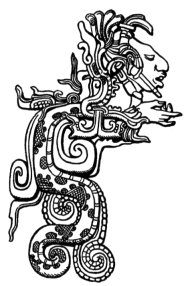
The Vision Serpent is an important creature in Pre-Columbian Maya mythology, although the term itself is now slowly becoming outdated.
The serpent was a very important social and religious symbol, revered by the Maya. Maya mythology describes serpents as being the vehicles by which celestial bodies, such as the sun and stars, cross the heavens. The shedding of their skin made them a symbol of rebirth and renewal.
They were so revered, that one of the main Mesoamerican deities, Quetzalcoatl, was represented as a feathered serpent. The name means "Precious/feathered serpent" (from Nahuatl, "quetzalli" is used to describe the bird, its feathers, or something precious depending on the context and "coatl" meaning snake or serpent.).[1]
The Vision Serpent is thought to be the most important of the Maya serpents. "It was usually bearded and had a rounded snout. It was also often depicted as having two heads or with the spirit of a god or ancestor emerging from its jaws." During Maya bloodletting rituals, participants would experience visions in which they communicated with the ancestors or gods. These visions took the form of a giant serpent "which served as a gateway to the spirit realm." The ancestor or god who was being contacted was depicted as emerging from the serpent's mouth. The vision serpent thus came to be the method in which ancestors or gods manifested themselves to the Maya. Thus for them, the Vision Serpent was a direct link between the spirit realm of the gods and the physical world.[2]
The Vision Serpent goes back to earlier Maya conceptions and lies at the center of the world as they conceived it. "It is in the center axis atop the World Tree. Essentially the World Tree and the Vision Serpent, representing the king, created the center axis which communicates between the spiritual and the earthly worlds or planes. It is through ritual that the king could bring the center axis into existence in the temples and create a doorway to the spiritual world, and with it power."[3]
The Vision Serpent is prevalent in bloodletting ceremonies, in Maya religious practices, Maya jewelry, pottery and their architecture.